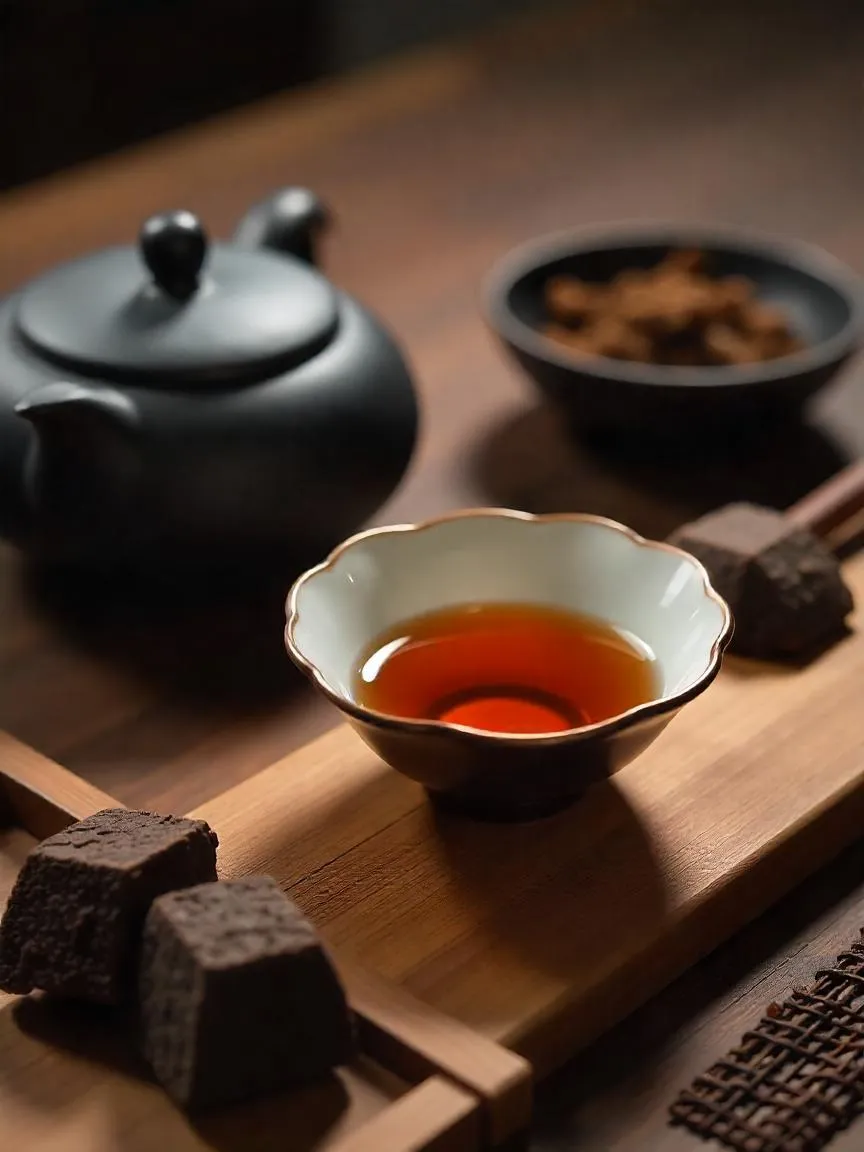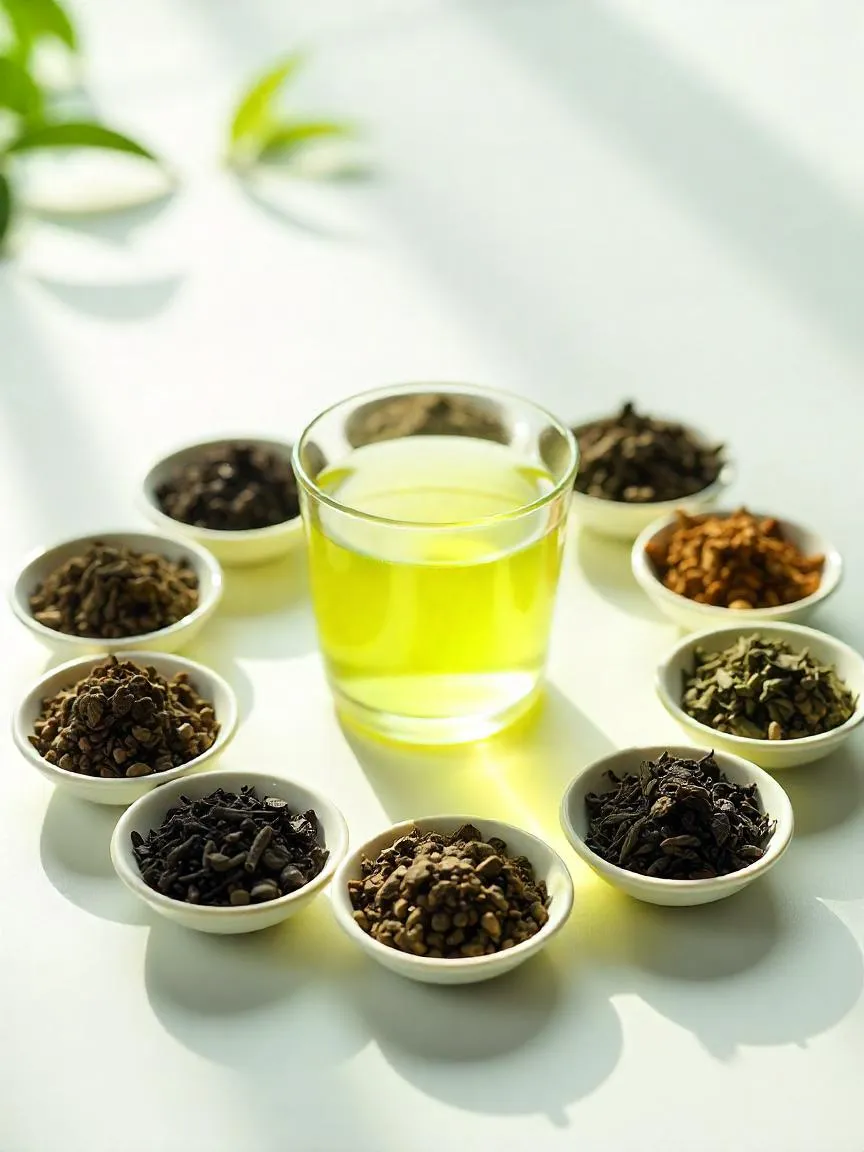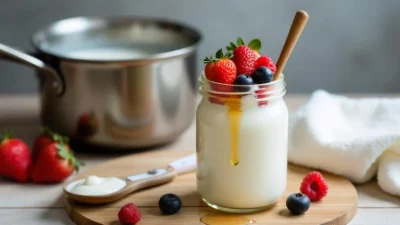Contents
- 🍵 The Origins of the Chinese Tea Ceremony: History and Heritage 🇨🇳
- 🌿 Cultural Impact of the Chinese Tea Ceremony: Connection, Respect & Legacy 🇨🇳🍵
- 🍃 Tea Types and Selection: Choosing the Right Tea for the Ceremony 🇨🇳🍵
- 🍂 Oolong & Pu-erh Teas: Rich, Complex, and Full of Character 🇨🇳🍵
- 🍵 Traditional Tea Ceremony Equipment: Tools of the Chinese Gongfu Cha 🇨🇳🫖
- 🍵 Performing the Chinese Tea Ceremony: A Step-by-Step Guide to Mindful Brewing 🇨🇳🧘♂️
- 🍵 Traditional Chinese Tea Recipes: Master the Art of Brewing at Home 🇨🇳🫖
- 🍵 Conclusion: The Timeless Essence of the Chinese Tea Ceremony 🇨🇳✨
The Chinese tea ceremony is much more than simply brewing tea — it’s a meditative ritual deeply rooted in China’s rich cultural heritage, symbolizing mindfulness, respect, and connection. 🍃
From the careful selection of tea leaves to the elegant brewing techniques, every step of the process honors centuries-old traditions. The ceremony not only creates a sensory experience of taste and aroma but also invites participants to slow down, appreciate nature, and share moments of quiet reflection.
For tea lovers and cultural explorers alike, discovering the secrets behind the Chinese tea ceremony — along with authentic tea recipes — opens the door to one of the world’s most beautiful and ancient practices. 🧘♂️🌿
🍵 The Origins of the Chinese Tea Ceremony: History and Heritage 🇨🇳
The Chinese tea ceremony is more than a method of making tea — it’s a profound cultural ritual shaped by centuries of tradition, philosophy, and artistry. 🌿 Its origins reveal how tea evolved from a simple medicinal drink into an elegant practice that mirrors the core values of Chinese civilization.
📜 Historical Significance
- 🏺 Tang Dynasty (618–907 AD):
Tea drinking first gained prominence during this era, moving beyond medicinal uses into daily life. It became a symbol of hospitality and social interaction. - 🎨 Song Dynasty (960–1279 AD):
The ceremony began to emphasize refinement, technique, and presentation. Tea preparation evolved into a graceful ritual, reflecting Confucian ideals such as respect (敬), harmony (和), purity (清), and tranquility (寂). - 🏯 Ming Dynasty (1368–1644 AD):
Innovations like loose-leaf tea and the gaiwan (lidded tea bowl) transformed the brewing process into a true art form. Ming scholars and literati often used tea gatherings as settings for poetry, painting, and philosophical discussions.
🌏 Why the Tea Ceremony Matters
- 🧘♂️ Mindfulness in Action:
Each movement is intentional, designed to bring awareness and serenity. - 🤝 A Symbol of Connection:
Serving tea became a ritual of respect and hospitality, strengthening social bonds. - 🍃 Reflection of Nature:
Tea’s simple, pure essence connects participants to the natural world, a core principle in Daoist and Confucian philosophy.
✅ In short:
The Chinese tea ceremony is a beautiful expression of centuries-old values — harmony, respect, and mindfulness — making it not just a cultural tradition, but a living philosophy. 🍵✨
🌿 Cultural Impact of the Chinese Tea Ceremony: Connection, Respect & Legacy 🇨🇳🍵
The Chinese tea ceremony extends far beyond its brewing techniques — it plays a deep cultural role, strengthening relationships, fostering mindfulness, and influencing global tea traditions. 🌏
🌟 A Ritual of Hospitality and Respect
- 🤝 Symbol of Welcome:
In Chinese culture, serving tea is a timeless gesture of hospitality, showing respect to guests, elders, and family members. - 👨👩👧👦 Family Bonding:
Tea ceremonies often mark important life events, such as weddings, where offering tea to elders signifies gratitude and respect. - 🏠 Social Connection:
Sharing tea creates space for meaningful conversation, reflection, and deeper personal connections.
🧘♂️ Mindfulness and Presence
- 🕰 Focus on the Moment:
The deliberate pace of the tea ceremony invites participants to slow down, appreciate each movement, and cultivate mindfulness. - 🍃 Harmony with Nature:
Every aspect — from water temperature to the scent of the leaves — reflects an intimate relationship with nature, honoring Daoist and Confucian philosophies.
🌏 Global Influence of Chinese Tea Culture
- 🇯🇵 Inspiration for Other Tea Traditions:
The Chinese tea ceremony deeply influenced Japanese Chanoyu (茶の湯), as well as Korean and Vietnamese tea practices. - 🌐 Modern Tea Culture:
Principles of hospitality, simplicity, and mindfulness continue to inspire global tea communities, tea houses, and wellness practices.
✅ In short:
The Chinese tea ceremony is not just a ritual — it’s a living expression of hospitality, harmony, and global cultural exchange, offering timeless lessons in connection and presence. 🍵🌿
🍃 Tea Types and Selection: Choosing the Right Tea for the Ceremony 🇨🇳🍵
Selecting the proper tea is one of the most important aspects of the Chinese tea ceremony, as each variety carries its own story, flavor, and cultural meaning. 🌿
The choice of tea influences the entire experience — from aroma to taste, from visual beauty to the overall mindfulness of the ritual.
🌿 Green Tea Varieties: The Essence of Freshness
Green tea holds a special place in Chinese tea culture. Its minimal oxidation preserves the natural flavor of the leaves, producing a refreshing, delicate brew that highlights purity and simplicity.
🍵 Longjing (Dragon Well, 龙井茶)
- 📍 Origin: Hangzhou, Zhejiang Province
- 🍃 Appearance: Flat, smooth, jade-green leaves
- 🌸 Flavor Profile: Sweet, nutty, with subtle floral undertones
- 🌿 Aroma: Fresh, grassy, and lightly roasted
Longjing is one of China’s most famous and respected green teas, often served to honored guests and featured in state ceremonies.
🍵 Biluochun (碧螺春)
- 📍 Origin: Dongting Mountain, Jiangsu Province
- 🍃 Appearance: Tightly rolled, curly leaves with fine white hairs
- 🌸 Flavor Profile: Light, floral, with a hint of fruitiness
- 🌿 Aroma: Delicate, fruity, and highly fragrant
Biluochun is prized for its complexity and smoothness, making it a favorite for those seeking a more nuanced green tea experience.
🔎 How to Select Quality Green Tea
- ✅ Look for bright, vibrant leaves with even shapes and minimal broken pieces.
- ✅ Fresh aroma is a key indicator of quality — avoid stale or musty smells.
- ✅ Harvest season matters: Early spring teas (Ming Qian) are often the most delicate and flavorful.
✅ In short:
Choosing high-quality green tea brings out the beauty of the Chinese tea ceremony, allowing participants to savor freshness, purity, and the essence of nature in every sip. 🍵🌿
🍂 Oolong & Pu-erh Teas: Rich, Complex, and Full of Character 🇨🇳🍵
Beyond green tea, Oolong and Pu-erh teas offer some of the most complex, layered flavors in Chinese tea culture. 🌿 These teas reflect the mastery of fermentation, oxidation, and aging, producing distinct aromas, health benefits, and ceremonial experiences.
🍂 Oolong Tea: The Art of Balance
Oolong tea (乌龙茶) falls between green and black teas, undergoing partial oxidation that creates a wide spectrum of flavors. It’s often prized for its ability to evolve across multiple infusions, revealing new tasting notes with each steep.
🍵 Tieguanyin (Iron Goddess of Mercy, 铁观音)
- 📍 Origin: Fujian Province
- 🍃 Oxidation Level: Light to medium
- 🌸 Flavor Profile: Smooth, creamy, with floral notes like orchid or lilac
- 🌿 Aroma: Fragrant, lightly spicy, elegant
Tieguanyin is one of China’s most famous oolong teas, often associated with spiritual reverence and artistic refinement.
🍵 Da Hong Pao (Big Red Robe, 大红袍)
- 📍 Origin: Wuyi Mountains, Fujian Province (famous “rock teas”)
- 🍃 Oxidation Level: Medium to high
- 🌸 Flavor Profile: Bold, toasty, mineral-rich with hints of caramel and dried fruit
- 🌿 Aroma: Roasted, woody, and deeply complex
Da Hong Pao is highly prized and often considered one of the most prestigious Chinese teas, with some ancient mother trees producing legendary batches.
🔁 Special Feature: Multiple Infusions
- ✅ Oolong teas can be brewed 5–7 times, evolving in taste with each steep.
- ✅ The first infusion may highlight florals; later infusions deepen into creamy, roasted, or nutty notes.
🍃 Pu-erh Tea: The World of Fermentation
Pu-erh tea (普洱茶) is unique to Yunnan Province and famous for its fermentation process, which creates profound depth and health benefits. Like fine wine, Pu-erh tea becomes more complex with age.
🍵 Sheng (Raw) Pu-erh
- 📍 Processing: Naturally aged over years or decades
- 🌸 Flavor Profile: Bright, slightly grassy, floral, with aging adding complexity
- 🌿 Aroma: Fresh, vegetal, with subtle sweetness
Sheng Pu-erh is lively and dynamic, perfect for aging and prized by tea collectors.
🍵 Shou (Ripe) Pu-erh
- 📍 Processing: Artificially fermented for quicker aging
- 🌸 Flavor Profile: Smooth, earthy, mellow, often with notes of cocoa or dried fruit
- 🌿 Aroma: Earthy, woody, sometimes resembling forest floor
Shou Pu-erh offers immediate richness, making it a popular introduction to fermented teas.
🔎 How to Select Quality Oolong & Pu-erh Teas
- ✅ Origin matters — seek authentic regions like Fujian for Oolong or Yunnan for Pu-erh.
- ✅ Look for whole, unbroken leaves and minimal stems or dust.
- ✅ For Pu-erh: Pay attention to age, storage conditions, and reputable producers.
✅ In short:
Oolong and Pu-erh teas invite tea lovers into the deeper layers of Chinese tea culture — where flavor, history, and craftsmanship meet in every cup. 🍂🍵✨
🍵 Traditional Tea Ceremony Equipment: Tools of the Chinese Gongfu Cha 🇨🇳🫖
The Chinese tea ceremony is not only about the tea itself — it’s about the precision, mindfulness, and beauty of the tools involved.
Each piece of equipment serves a specific purpose, enhancing both the brewing process and the sensory experience of enjoying tea. 🌿
🍶 Teapots and Brewing Vessels
🫖 Yixing Clay Teapots (宜兴紫砂壶)
- ✅ Material: Porous purple clay (zisha) from Yixing, Jiangsu
- ✅ Benefit: Absorbs the aroma and essence of the tea over time, enriching future brews
- ✅ Best for: Oolong, Pu-erh, and black teas
- ✅ Special note: Often dedicated to a single type of tea to preserve purity of flavor
🍚 Gaiwan (盖碗)
- ✅ Structure: Porcelain bowl with a lid and saucer
- ✅ Benefit: Allows full viewing, control of steeping, and appreciation of leaf unfurling
- ✅ Best for: Green, white, and delicate oolong teas
🍶 Porcelain or Glass Teapots
- ✅ Material: Non-porous, neutral; preserves pure taste
- ✅ Benefit: Ideal for beginners or tasting multiple tea types without cross-flavoring
- ✅ Best for: Green, white, or floral teas
🍵 Tea Cups and Utensils
🧉 Tea Cups (茶杯)
- ✅ Small cups: Encourage slow sipping to fully appreciate aroma, taste, and texture
- ✅ Material: Porcelain, ceramic, or glass
- ✅ Tasting sets: Often include aroma cups to enjoy fragrance before sipping
🥄 Tea Utensils
- Tea Scoop (茶则): Accurately measures loose leaves
- Tea Tweezers (茶夹): Handle cups hygienically
- Tea Funnel (茶漏): Guides leaves into narrow teapot openings
- Tea Strainer (茶滤): Catches stray leaves during pouring
- Tea Needle (茶针): Unclogs teapot spouts
- Tea Whisk (茶筅): Occasionally used for frothy teas or whisking powdered teas
🪵 Tea Trays and Accessories
🪵 Tea Tray (茶盘)
- ✅ Function: Organizes tools and collects water overflow
- ✅ Design: Wooden, bamboo, or stone; many feature drainage holes and hidden water collection systems
- ✅ Purpose: Keeps the brewing area clean and elegant
🔥 Water Kettle (烧水壶)
- ✅ Controls water temperature for optimal brewing
- ✅ Essential for precision steeping with sensitive teas like green or white
🧻 Tea Towels & Cloths (茶巾)
- ✅ Keep hands, cups, and surfaces clean during brewing
🎯 Why Each Tool Matters
- 🧘♂️ Mindfulness: Each step of using the tools promotes focus and calm
- 🌿 Aroma Preservation: Materials like Yixing clay or porcelain bring out tea’s natural aromas
- 🎎 Ceremonial Beauty: Tools reflect the aesthetics of Chinese artistry and respect for the tea itself
✅ In short:
The tools of the Chinese tea ceremony elevate the act of brewing into an art — blending precision, tradition, and sensory enjoyment into every cup. 🍵✨
🍵 Performing the Chinese Tea Ceremony: A Step-by-Step Guide to Mindful Brewing 🇨🇳🧘♂️
The Chinese tea ceremony is not rushed — it is a graceful process that transforms tea preparation into an art of mindfulness, precision, and cultural respect. 🌿
Every movement, from preparation to serving, reflects centuries of refined tradition, elevating the simple act of brewing tea into a meditative ritual.
🧹 Preparation Steps: Setting the Stage for Serenity
Before the first leaf touches water, careful preparation ensures a flawless ceremony.
✅ Gather Essential Equipment:
- High-quality loose-leaf tea (Oolong, Green, Black, Pu-erh, White)
- Yixing teapot or Gaiwan
- Aroma and tasting cups
- Tea scoop, strainer, funnel, and tea towel
- Water kettle (preferably temperature-controlled)
✅ Ensure Cleanliness:
- Thoroughly rinse and warm all vessels to avoid unwanted flavors.
- Warming cups and teapots also helps release the tea’s aroma.
✅ Use High-Quality Water:
- Fresh, filtered water enhances clarity and taste.
- Avoid distilled or heavily chlorinated tap water.
✅ Create a Calm Environment:
- Soft music, quiet surroundings, and respectful silence invite mindfulness and appreciation.
🔬 Brewing Techniques: The Heart of the Ceremony
Brewing tea during the ceremony requires attention to temperature, timing, and leaf quantity, as each type of tea demands its own approach.
🌡 Temperature Control
| Tea Type | Water Temperature |
|---|---|
| Green Tea | 160–180°F (70–80°C) |
| White Tea | 170–185°F (75–85°C) |
| Oolong Tea | 190–200°F (90–93°C) |
| Black Tea | 200–212°F (93–100°C) |
| Pu-erh Tea | 205–212°F (96–100°C) |
- Using water that is too hot can burn delicate leaves, while cooler water may not fully extract complex flavors.
⏳ Steeping Time
| Tea Type | Steeping Time |
|---|---|
| Green Tea | 1–3 minutes |
| Oolong Tea | 3–5 minutes |
| Pu-erh Tea | 2–5 minutes |
| Black Tea | 2–4 minutes |
| White Tea | 3–5 minutes |
- Always observe the tea’s color and aroma to adjust steeping for personal preference.
⚖ Leaf Measurement
- Typically use 3–5 grams of loose leaves per 150 ml of water.
- Consistent leaf quantity ensures balanced, repeatable results.
🔁 Multiple Infusions
- Many Chinese teas, especially Oolong and Pu-erh, can be infused multiple times, revealing new layers of aroma and taste with each steep.
🎯 The Mindful Serving
- Pour tea gently and evenly into small tasting cups.
- Allow participants to admire color, inhale aroma, and savor each sip slowly.
- The ceremony invites both host and guest into a shared moment of harmony and presence.
✅ In short:
Performing the Chinese tea ceremony is a delicate balance of technique, patience, and mindfulness — where every detail honors both the tea and the people who share it. 🍵✨
🍵 Traditional Chinese Tea Recipes: Master the Art of Brewing at Home 🇨🇳🫖
Brewing Chinese tea properly is both a science and an art. Each type of tea has its own traditional method that brings out its best flavor, aroma, and character. 🌿
By learning these classic recipes, tea lovers can recreate the authentic Chinese tea experience in their own homes.
🍃 Classic Green Tea Recipe (绿茶)
Green tea requires gentle care to preserve its fresh, delicate flavors.
🔧 You’ll Need:
- 2 grams of loose green tea leaves per cup (such as Longjing or Biluochun)
- Fresh filtered water (175°F / 80°C)
- Gaiwan or glass teapot
🫖 Brewing Steps:
1️⃣ Preheat the teapot or gaiwan with hot water.
2️⃣ Add tea leaves.
3️⃣ Gently pour water (175°F / 80°C) over the leaves.
4️⃣ Steep for 2–3 minutes.
5️⃣ Strain and serve.
✅ Tips:
- Avoid boiling water to prevent bitterness.
- Best enjoyed plain. A thin lemon slice can subtly enhance brightness if desired.
🍂 Traditional Oolong Tea Recipe (乌龙茶)
Oolong teas like Tieguanyin and Da Hong Pao reveal layers of complexity when brewed traditionally.
🔧 You’ll Need:
- 5 grams of loose oolong leaves per cup
- Water heated to 195°F (90°C)
- Yixing teapot or gaiwan
🫖 Brewing Steps:
1️⃣ Briefly rinse leaves with hot water for 5–10 seconds (“wake up” the leaves).
2️⃣ Pour hot water (195°F) into the teapot.
3️⃣ Steep for 3–5 minutes depending on strength preference.
4️⃣ Strain and serve.
✅ Tips:
- Oolong can be re-steeped 5–7 times, revealing new flavors with each infusion.
- Pairs wonderfully with light snacks or pastries.
🍄 Authentic Pu-erh Tea Recipe (普洱茶)
Pu-erh tea, with its earthy richness, follows a slightly different ritual, emphasizing rinsing and multiple infusions.
🔧 You’ll Need:
- 5–7 grams of Pu-erh leaves (Sheng or Shou)
- Boiling water (212°F / 100°C)
- Gaiwan, Yixing teapot, or large glass vessel
🫖 Brewing Steps:
1️⃣ Rinse leaves: Pour boiling water over leaves, swirl for 10 seconds, then discard rinse water.
2️⃣ Pour fresh boiling water.
3️⃣ Steep first infusion for 4–5 minutes.
4️⃣ Shorten steeping time slightly for subsequent infusions.
✅ Tips:
- Pu-erh can be steeped many times, often improving over multiple brews.
- Excellent with meals, especially savory or rich foods.
🎯 Summary Brewing Chart:
| Tea Type | Leaf Amount | Water Temp | Steep Time | Multiple Infusions? |
|---|---|---|---|---|
| Green Tea | 2g | 175°F (80°C) | 2–3 min | 2–3 times |
| Oolong Tea | 5g | 195°F (90°C) | 3–5 min | 5–7 times |
| Pu-erh Tea | 5–7g | 212°F (100°C) | 4–5 min | 5+ times |
✅ In short:
Mastering these traditional recipes allows tea lovers to honor the art of Chinese tea preparation and experience its authentic flavors right at home. 🍵✨
🍵 Conclusion: The Timeless Essence of the Chinese Tea Ceremony 🇨🇳✨
The Chinese tea ceremony is far more than the simple act of drinking tea — it is a living tradition that weaves together culture, philosophy, and human connection. 🌿
🌿 A Ceremony Rooted in Harmony and Respect
- 🤝 Connection:
Sharing tea creates a space for meaningful interaction, strengthening bonds among family, friends, and even strangers. - 🧘♂️ Mindfulness:
Every step — from preparation to sipping — encourages participants to slow down, be present, and appreciate each moment. - 🏯 Cultural Heritage:
The ceremony reflects values that have been passed down for centuries: respect, balance, simplicity, and appreciation for nature.
🔑 Key Elements of the Tea Ceremony
- Preparation:
Selecting high-quality tea leaves and using well-maintained tools to honor the leaves’ natural essence. - Brewing:
Applying precision in temperature, timing, and infusion to unlock the full spectrum of flavors. - Serving:
Presenting tea with elegance, care, and gratitude — reinforcing the importance of hospitality and respect.
🍃 A Journey Through Tea Varieties
Whether it’s the fresh clarity of green tea, the layered complexity of oolong, the rich depth of Pu-erh, or the smooth warmth of black tea, each variety offers a unique experience within the same sacred ritual.
✅ In short:
The Chinese tea ceremony is not simply about tea — it’s a philosophy of life that celebrates mindfulness, tradition, connection, and the quiet beauty found in simplicity. 🍵🌿✨











Sounds beautiful! I’d love to learn more about the authentic recipes mentioned.